The 135mm primes with a modern APS-C sensor, a non-scientific comparison
NOTICE: I am not an English speaker. Some phrases in this text may be incorrect or sound odd, but I think that this sort of article must reach the widest public: not many are interested in trying legacy lenses on modern, digital cameras, and if I were writing in Italian, the not-so-many would become a few ones!
Following some other articles of mine about some legacy lenses, and especially a few, cheap wide-angles, (look for more in the site index), I am now exploring the quality of a few 135mm glasses, namely:
- the Pentax-M 135mm f/3.5, very common on the 2nd hand market
- the Pentax-A 135mm f/2.8, reputably better than the previous
- the Auto Chinon 135mm f/2.8, not well-known, rarely reviewed but promising, M42 screw mount
- UPDATE: the Auto Chinon 135mm f/2.8, same as above but with Pentax bajonet mount
I must say that, after some quick shots when I first came in possessions of these primes, I had misjudged them, most likely because I just mis-focused, but I'm hopefully doing better here.
I must apologize, though, because I only took a couple of decent 40mt-distance (you can call it "infinity") tests, but I've been quite fretful for the shorter portrait distance, taken indoor but without a proper stabilization, so I'm not posting about it here.
Again, I am relying on the Fujifilm XT-20 with its 24 mega-pixel sensor. The Pentax K50, my other camera, may seem a natural choice here, with its Pentax bajonet that can natively host two lenses of the three, but when it's test time I prefer the Fuji because:
- it has some more pixels and so it can better tell about the lenses sharpness (the K50 has 16M, not 24M)
- it better helps focusing -a mirrorless has its advantages- though in plain light I often find the focus peak more disturbing than not helping
- the JPEG processing of the Fuji is so incredibly good that I don't need to work the RAW files (not for the purpose of this test, at least), a time-saving feature
A few considerations
The two Pentax items are quite compact and relatively light, where the Chinon are bigger though not much; someway, though, the difference is perceivable. Let's say that the Pentax can make you feel you're working with a walk-around lens, the Chinon makes you feel you're actually carrying a short tele.
Mounted on the Pentax reflex, the difference would be less evident while the adapters for the Fuji add length of their own. Notice that, on the Pentax, even the M42 adapter is super-thin: the [flange] distance from the focal plane is almost the same, or maybe exactly the same -I'm not an expert- for the PK bajonet and the M42 screw.
The minimal focusing distance for the Pentax-A is 120cm while the others need 150cm. A small gap but if you need to shoot something on the ground, you can see the difference: 150cm will force you to stretch your body and possibly stand on tip-toe. Obviously these lenses are not macro, but a shorter minimal distance is always welcome.
NOTICE: I haven't checked this for the PK-bajonet Chinon because it came later, but I'm rather confident that it is just as the other Chinon.
The lenses are all in good shape, the mechanisms are beautifully fluid and firm, apparently the three items have been well-treated by their respective owners.
Focusig is comfortable and smooth with all of these three lenses, but while the Pentax-A just provides the right resistance, the Chinon (both variants) and the Pentax-M are a bit stiffer.
Also, the Chinon has a much longer throw than the Pentax-A (50% I'd say); you may or you may not like it, I prefer the Pentax-A in this respect but it is known that a longer throw can help to focus more precisely.
Also the aperture controls provide the right resistance, but again, the Chinon is on the stiffer side.
All the three four lenses come with a useful, very handy, retractible lens hood. Sometimes it slips (especially in the case of the Chinon M42), which can be less handy.
Quick analysis of the 135mm contenders
First, a note on aberrations: you may argue that I've not explored this topic but the images tell that there isn't much to worry about, even though lateral chromatic aberrations definitely deserve a better look, there is some.
Also, I haven't checked the flare resistance, I'd lie if I say that I'll do it... I don't care much for the moment. I can only tell that I experienced the PK Chinon take a bad hit from a light near the field of the picture.
Overall, to be honest, I really wished for the Pentax-A to win the test, because it is the most useful equipment piece for me: it is compact, it has the f/2.8 (opposed to Pentax-M), sports Auto-Aperture that perfectly works with digital Pentax bodies (none of the other two lenses does), the focus ring is the best of the three and finally... I don't like screws in general (not to mention the fact that the cheap M42 adapters for the Pentax are painfully dangerous for the camera, and I would not swear on the better ones, too).
UPDATE: now that I also checked the Chinon with the Pentax bajonet, the advantages of the Pentax-A are less evident, if it were not for the aperture automatism.
Also, though I haven't been scientific on this, the Pentax-A seems focus-shift free; the M42 Auto-Chinon, instead, may suffer from a hair of focus-shift (or maybe it is just an impression). UPDATE: the PK-bajonet Chinon doesn't manifest any focus-shift, so likely also the screw version is OK.
As said, the Chinon is also heavier, marginally bulkier (dimensions tell otherwise, but it is definitely somewhat less handy).
The aperture controls/marks on the M42-screw Chinon were placed downward once it was screwed in, but my M42-FX adapter can bem easily... adapted (pun not intended) and the marks went were they should be, so it is not an issue in the end (but another small annoyance from screw mount!).
From the point of view of compactness, the Pentax-M is on par with the Pentax-A cousin, but it obviously lacks the auto-aperture and the f/2.8 features. Maybe the center and the borders are not exactly on the same plane (or the lens in my possession can be a little de-centered), or simply border quality is not on par with the others.
In general, once stopped down, differences for practical purposes between the three lenses are small to minimal, as you will see from the crops: they are quite usable, definitely sharp at f/5.6 but already very good at f/4; in real life, with APS-C sensors, I think they can deliver more or less the same results. Actually, you can happily live with one or another.
Just a word about colours: they are good and vibrant, nothing to complain here.
The Chinon and the Pentax-A deliver practically the same result, and I can assure that it is consistent with what I see with the naked eye, an excellent outcome, though for the yellows I prefer the Pentax camera rendition (not shown here, the images are both from the Fuji XT-20, because I perceive a green nuance in one of the stripes in the image that is a bit diminished by the Fuji processing. Or maybe it's just the film simulation (Fuji JPEG files simulate different films, according to the settings).
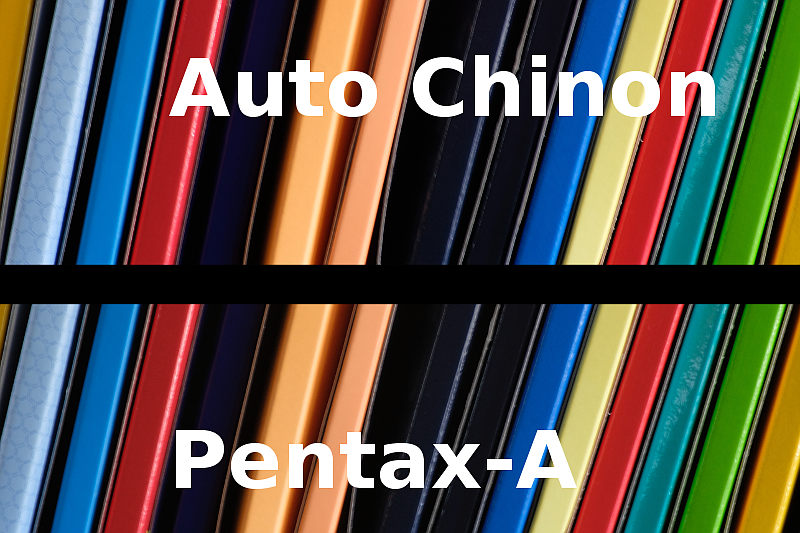
When it comes to decide for a sharpness champion, the Auto-Chinon is definitely better especially because it delivers already-good results at f/2.8. The larger diameter of the front lens probably help with borders, and the Chinon is the best candidate for the upper hand with full-frame sensors, but that I cannot test.
Also, the Chinon seems a bit better for general IQ, maybe it has a bit of "3D pop", but we're going into personal test zone here.
The Pentax-A is marginally better than the Pentax-M from almost all points of view, save for what I haven't tested so I cannot tell about: chromatic aberrations, distorsion, other less obvious aberrations such as coma, etc.
But the images I shot speak for theirselves and tell me that if there is some, it is not much. Conclusion: given the obvious advantage of f/2.8 of the former (the Pentax-A), the latter is not a contender: the only score for the Pentax-M comes from its low price and wide availability, while you can expect to pay a little premium for the Pentax-A.
I handle to you the crown, decide on which head it should go: for the best optical performance on APS-C, the Auto-Chinon wins (and maybe you're a fan of the M42 screw, I am not), but for most other parameters (mainly handling) I'd rather make the Pentax-A be the king.
UPDATE: obviously, with the PK bajonet Chinon the scale is pending on the Chinon side even more.
Anyway, let me be clear again: these are good lenses, all of them.
Summary: the Chinon has the best image overall, the M42-screw and the PK-bajonet variants seem to perform identically, also the look of the products is practically identical.
The Chinon M42 is not very handy, the PK variant is better because of the bajonet, though they're both a bit stiff in general.
On Pentax digital bodies, one advantage of the Pentax-A 135mm is the "A" mode on the aperture ring: with a digital camera you can control the aperture via the camera commands, though I prefer to use the ring. But beware that you may not be able to use the aperture ring at all, apart from the "A" mode, this thing is not fully clear to me and I want to ask to the Pentax Forums site soon!
The other advantage is the smaller dimension.
On the other side, with Pentax bodies, one good thing with the PK-bajonet Chinon is that it closes the blades only at shoot time, while you can comfortably focus at f/2.8 that usually concedes plenty of light.
The Pentax-M is a good lens but not on par with the others; also, the f/3.5 minimal aperture makes manual focusing a bit harder; I found the difference quite perceivable.
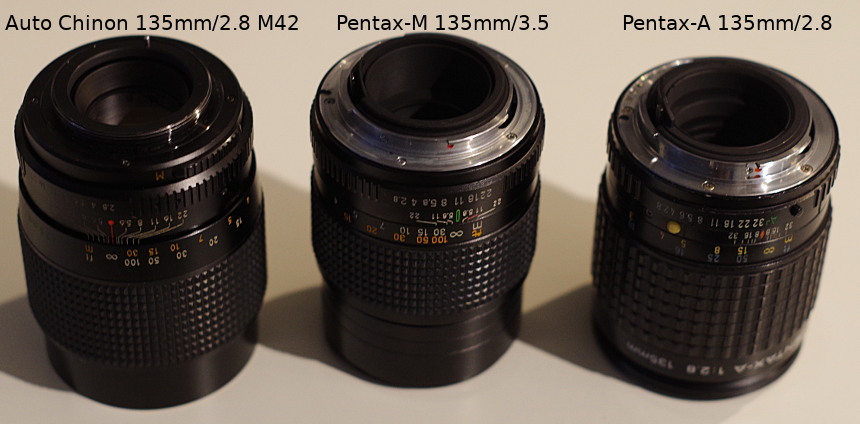 In the image above, the three contenders are photographed together.
In the image above, the three contenders are photographed together.Notice how the Chinon is just slightly bulkier.
Sharpness by aperture
At f/2.8, the Chinon is already good, both in the center and at the corners.
The Pentax-A trails.
At f/4, all the lenses do fine, the Pentax-M is surprisingly good for a cheap lens but still behind the other two.
At f/5.6 the result are from good to almost-excellent and you can definitely pick f/5.6 or f/8 for optimal performance.
"Almost excellent" is what best describes the behaviour at the smaller apertures, as you can see the 100% crops never show super-sharpness, or maybe it is the micro-contrast that is not super.
For the crops at full aperture, don't let the Pentax-M fool you: there is a big difference between f/3.5 and f/2.8, and there is nothing out of ordinary if the Pentax-M at f/3.5 beats the other two at f/2.8. Indeed, it proves a good lens anyway but the fact that the Pentax-A and the Chinon are already this good at f/2.8 is not something I expected.
The crops
UPDATE: as for the two Chinon items, given the identical performance, what I say here about optical performance applies to both of them.
The images contain 100% crops from the photos.
All lenses has been tested twice for each aperture (refocusing each time), in two different tests.
So, for each aperture, I picked the best crop for the centre and the border.
The centre is the tile on the top-right.
In each row, the left cell shows the image from the first test, the right cell is for the second test.
| Pentax-M at ** f/3.5 ** | |

|
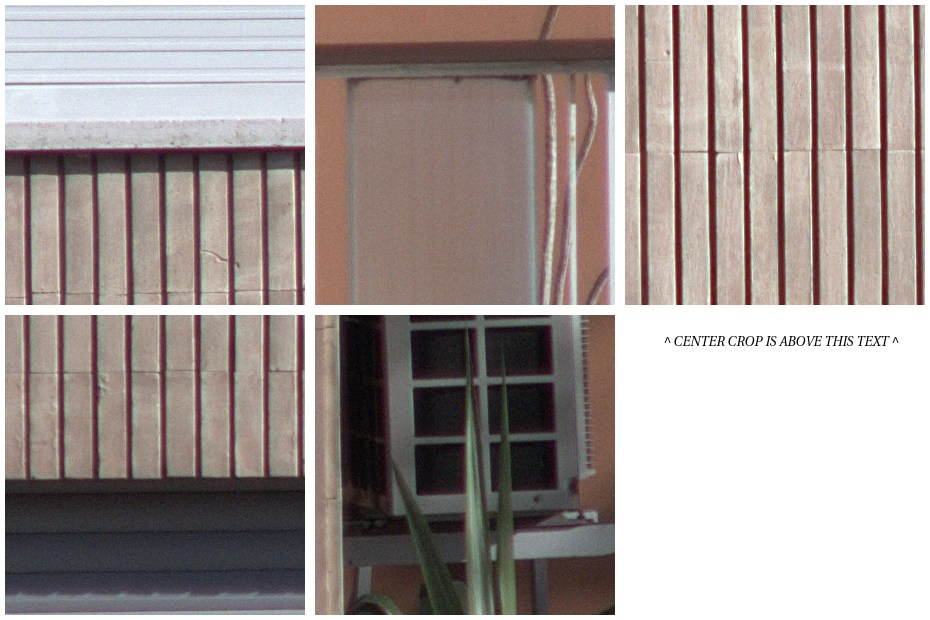
|
| Pentax-A at f/2.8 | |

|
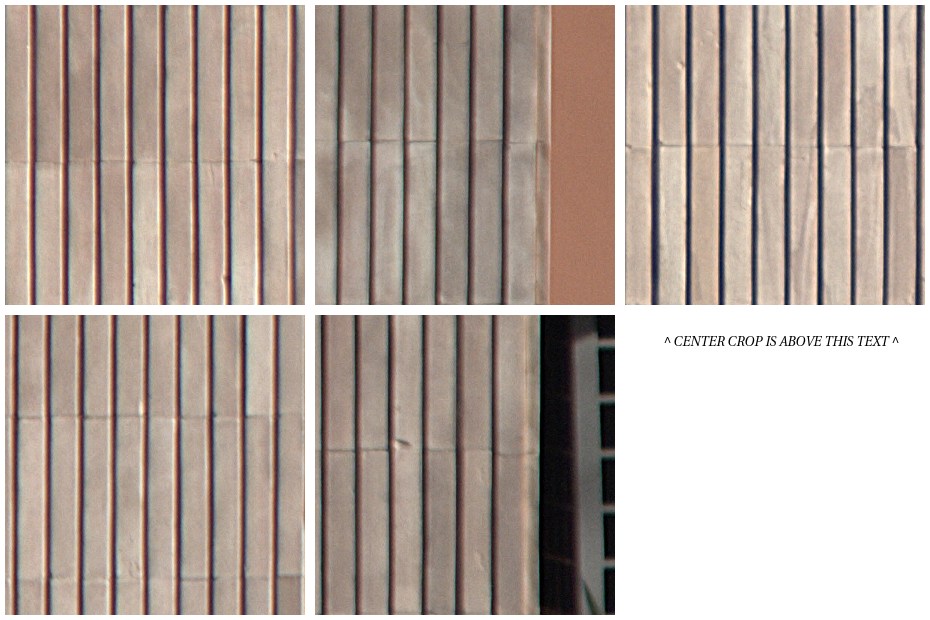
|
| Auto Chinon at f/2.8 | |

|

|
| Pentax-M at f/4 | |

|

|
| Pentax-A at f/4 | |

|

|
| Auto Chinon at f/4 | |
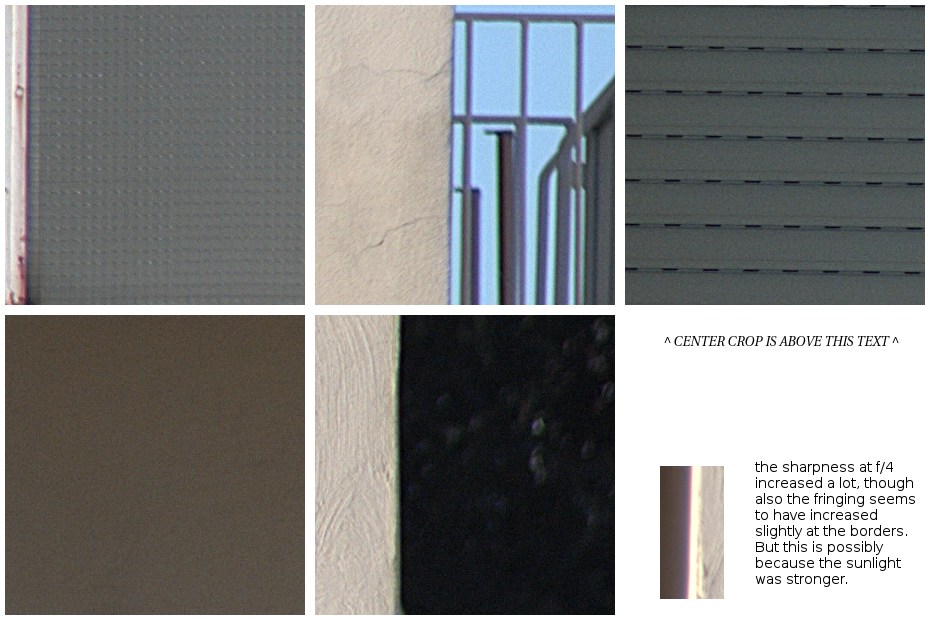
|

|
| Pentax-M at f/5.6 | |

|
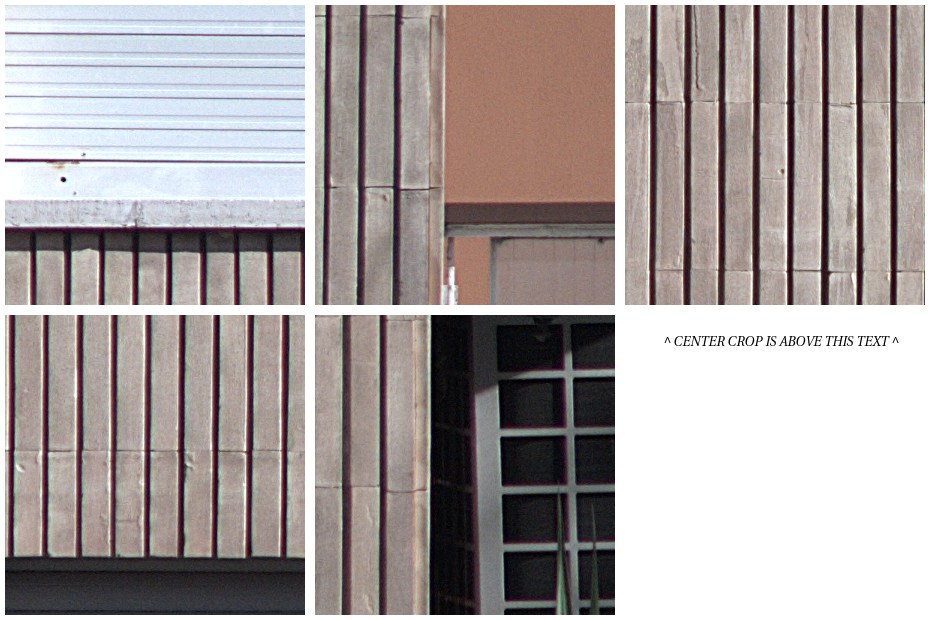
|
| Pentax-A at f/5.6 | |

|

|
| Auto Chinon at f/5.6 | |

|

|
| Pentax-M at f/8 | |
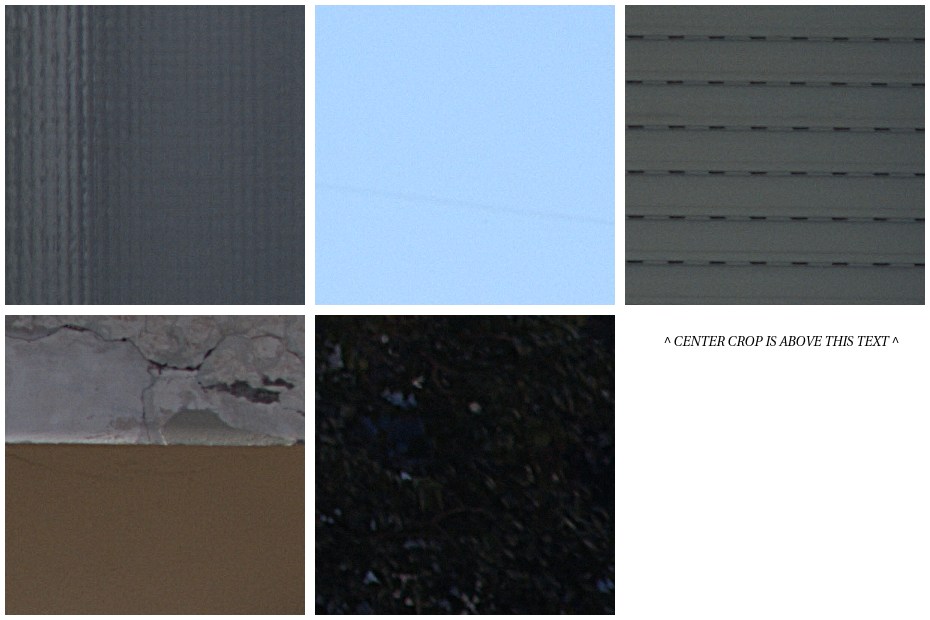
|

|
| Pentax-A at f/8 | |
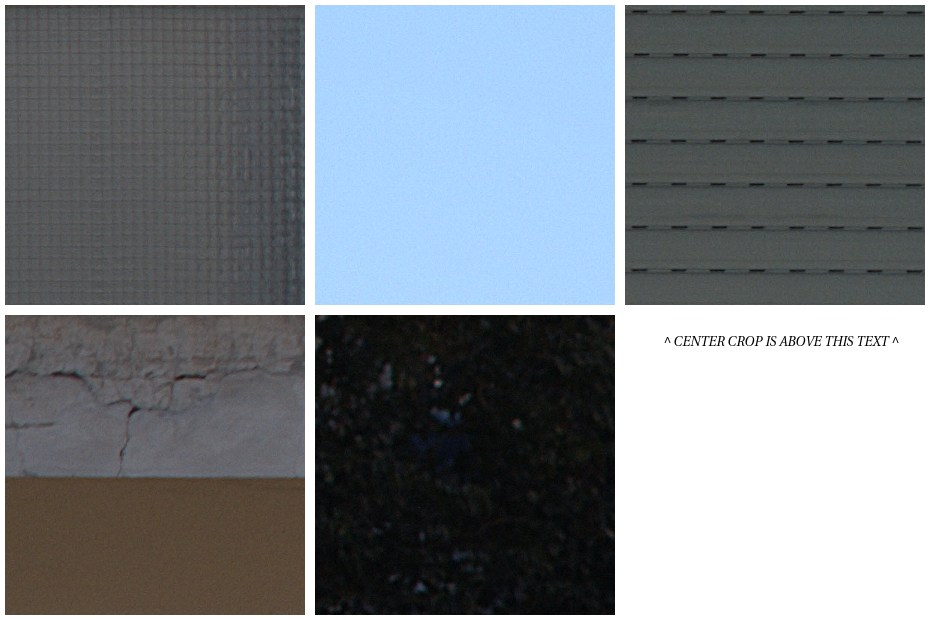
|

|
| Auto Chinon at f/8 | |

|

|

| Back to the site index | ||
| Do you love Italy? Check my little site, I hope to find the time to make it grow! | ||